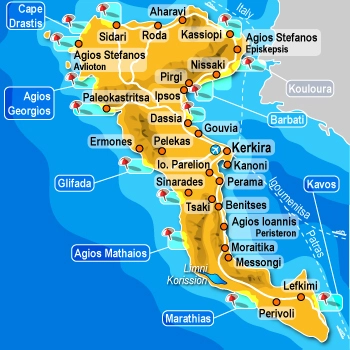The noble Corfu island is the northmost island of the Ionian Sea and is situated at the mouth of Adriatic Sea. Its northeast coasts are only 2 km from the Albanian coasts. Foreign visitors call it Corfu after the two tops of the old castle which are visible as the visitor approaches the island.
Tradition identifies Corfu Greece as the Homeric Scherios or as the island of Feakes, where Odysseus was accommodated during his return from Troy to Ithaca. It is also the same island where Argonauts took refuge when they were chased by the Colchis fleet during their return from Colchis after taking the Golden Fleece. A common feature in both myths is the hospitality of Feakes as well as their ability in sailing.

Corfu, today, is an international tourism centre and a destination with highly developed tourist infrastructures which satisfy even the most demanding visitors.
Corfu island is known for its beauties, its “kantounia” and its rich cultural tradition. In Corfu town you will notice the strong Italian impact in the architecture, since the Venice domination, which combined with the Greek Corfu tradition and formed this special culture. Corfu holidays offers many visits in museums, historic monuments, religious and other sites and a rich and beautiful coastline. Its vegetated inland, without falling short, scattered with many picturesque villages, rewards all visitors.
Beautiful and countless beaches for those who love cosmopolitan life, watersports and calm vacations. Many Corfu beaches are awarded by the European Authorities for their quality.The east coast, within the protective zone of the continental coasts, provides calm water for swimming, a rich seabed for exploration and has fairly easy access from the town. The norteast side is famous for its clear water, its multicolor pebbles for collecion and its steep dephth.
The southeast side is ideal for vacations with children. It has shallow waters, sand beaches with shade, taverns by the sea and The road comes up to the beach.
The west and south coast of the island are characterized by endless golden beaches and shallow blue and green waters. Some are much frequented and other are not.
The northwest side has large sand beaches, like St George, but also steep cliffs, like the rocks of Paleokastritsa, which are ideal for exploration.
What to Do in Corfu
• For the lovers of diving Corfu and the Near Islands are a top destination for underwater activities, especially after June when the sea is quite warm. Throughout Corfu you may find organised diving centres.
• Go on one of the favourite tours of the island from lake Antonioti, to St Catherine’s monastery.
• Taste traditional corfiot dishes, like pastitsada, bourdeto, sofrito and nouboulo with prosciutto and buy kumquat liqueur.
• Visit St Spiridon’s church where the saint’s holy relics is kept. A point of reference is the big bell tower of the church which dominates in the old Corfu town.
• Stroll in the Venice-like kantounia of the old town.
• Visit Achillion palace near Benitses and the many museums of the town.
• Stroll in the famous Spianada square and enjoy your coffee in “Liston” facing St. Michael and St. George’s palace and the imposing Old Castle.
• Photograph and enjoy Pontikonisi from Kanoni.
• Tour the Corfu castles to see its 2.500 years old history.
Sightseeing
Corfu (Kerkyra) includes the islands of Paxi and Diapontia islands. All this region is a sight itself, it is a living museum of art, history, nature and culture.
in summer 2007, the old town of Corfu with its two fortresses (old and new) was declared as one of the UNESCO World Heritage Monuments, as a remarkable architectural symbol, which represents an historically important era; the architectural remains cover many periods since the Venetian rule until 19th century, especially the periods of 16th and 17th century, where, according to the archives and all the elements, at the same place there was a byzantine settlement of 6th or 7th century A.D.
The historic centre of Corfu is the most important sight of Corfu island, with its kantounia, the narrow streets in the old town paved with cobblestones, with “Kampielo”, the oldest district of the island, with “Spianada”, the greatest square in Greece and one of the largest in Europe and the “Liston” arcade, to its west side, where restaurants and bistros abound.
Corfu Archaeological Sights and Castles
Corfu (Kerkyra) is being inhabited, at least, since the Palaeolithic age (year 100.000 B.C., Grava of Gardiki remains) and it is considered to be the Homeric island of Feakes (there is no archaeological proof of this). Its name “Kerkyra” or “Korkyra”, according to the local myth, it is after the daughter of Asopos and Methoni, who gave birth to Posidonas son, Feakas.
Corfu has not always been an island, but it was connected with the opposite epirotic coast when the first human presence was detected; at Aghios Mattheos mountain there were signs of Palaeolithic age, at Sidari signs of Neolithic age and at the northwestern villages Kefali, Afionas and Ermones settlements of the Copper age were found.
Corfu Churches and Monasteries
The island of Corfu (Kerkyra) is, mainly for historic reasons, full of churches. The historic churches of Corfu (Kerkyra) are connected with all the difficulties of its inhabitants during Medieval era and the continuous conquests and disasters of the island. Most of them are humble temples and there is no comparison as for their size with the temples of the West. Especially, the town of Corfu (Kerkyra) includes today approximately 35 active temples. The most important and famous temple is Aghios Spyridon, the patron saint of the island, where there are the relics of the saint.
Corfu Museums and Historical Monuments
Corfu (Kerkyra) has a very rich history and cultural tradition and is famous for its big number of museums. Its museums include rare and novel exhibits and meticulous collections and, moreover, some of them are unique, especially in Greece.
You will find important museums at the historic centre of Corfu (Kerkyra) town, which, in 2007, was listed in UNESCO’s World Heritage Monuments and it is the most important sight in the island.
All the museums are situated in Corfu (Kerkyra) town or very close to it (10-15km). The richest collection, historically, is found at the Archaeological museum of Corfu (Kerkyra), where predominates the famous gable of Gorgo of the 6th century, the most ancient saved stone gable.
Corfu Settlements and Destinations
In Corfu (Kerkyra), Paxi and Diapontia islands, there are more than a hundred villages and settlements. Some villages have remains and traces of the archaic or roman era, some are influenced by the Byzantine period, the Venetian period or the traditional architecture of the 18th, 19th and 20th century, but all of them are built in a beautiful green environment. Main features of these villages are the stone houses, the typical square with the traditional cafes, the neat churches, but, most of all, the simple and hospitable local people, with their beautiful stories about myths, pirates, traditions and funny incidents…
You can visit the villages Aghios Ioannis (in central Corfu (Kerkyra), with Kostas’ s picturesque tavern), Aghios Prokopios (in central Corfu (Kerkyra) with beautiful churches and the oldest olive tree in the island) and Pelekas (in central Corfu (Kerkyra), with the Paf Graffiti & Music Festival every summer and Keiser’s watch post, from where Wilhelm II, emperor of Germany, enjoyed the view and the sunset).
Useful Telephones
REGION OF IONIAN ISLANDS 0030 26613 61501-6, 61555
PREFECTURE OF CORFU 0030 2661362311
Corfu Tourist Police Service 0030 22610 39503, 30265
Corfu (Ipsos) Tourist Police Summer Service 0030 26610 93204






